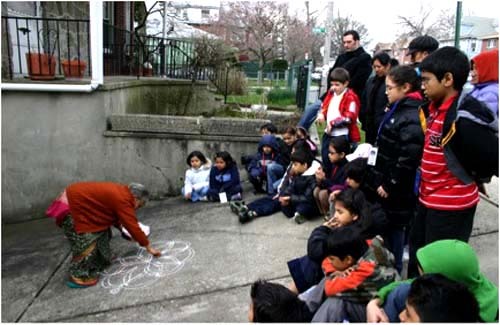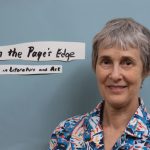Con Edison Immigrant Artist Program Newsletter, Issue No. 18
Featured Organization: City Lore
This month, IAP Program Officer Karen Demavivas interviewed Amanda Dargan, City Lore’s Education Director.
IAP: Can you tell us more about City Lore programs and activities that engage immigrant artists and audiences?
AD: City Lore engages immigrant artists and audiences through a variety of programs, such as our City of Memory ethnic neighborhood tours, where we work with community residents to create and host online tours of immigrant neighborhoods, such as our Indo-Caribbean tour of Richmond Hill, Queens, led by Pritha Singh, Executive Director of the Rajkumari Cultural Center, and a Russian tour of Brighton Beach, Brooklyn, led by Rita Kagan. For these and other City Lore programs, our staff works closely with local residents to identify and interpret places that are important to these immigrant communities.
Our methodology for working with communities is to identify a community spokesperson to pre-identify and videotape two or more spots for a prospective web-based tour of places significant to the community. The spokesperson working with us then invites 12-15 key members of the community to each workshop. At the workshop, the community spokesperson and the Place Matters team use the online “draft” of the City of Memory virtual tour as a starting-off point for the discussion that focuses on identifying places that matter to the community and the reasons for their importance. For communities who are new to the concept of preservation, identifying sites for the web exhibit and documenting them leads naturally into a discussion of other potential preservation and commemoration initiatives. Links to some of the tours and stories are:
- www.cityofmemory.org/map/#/tour/40/ (Russian New Immigrant Tour, led by Rita Kagan).
- www.cityofmemory.org/map/#/tour/36/ (South Asian Tour, led by Madhulika Khandelwal).
- www.cityofmemory.org/map/index.php#/tour/75/ (Indo-Caribbean Tour, led by Pritha Singh.
In addition, City Lore has and is developing a series of programs with ethnic and new immigrant poetry communities in New York. With recent funding from the Rockefeller Foundation, the Two Boots Corporation, and the National Endowment for the Arts, we are working on a series of poetry presentations in local NYC neighborhoods. We are working with the Garifuna, Indo-Caribbean, Pakistani, West African, Dominican, and other communities on a program that will host live poetry presentations in multiple languages. We are also designing and implementing a “poemobile” that will project poems on the sides of buildings in ethnic neighborhoods. The poems will be in multiple languages, and we will work with a “poetry ambassador” from each community. Finally, the project will result in a directory of ethnic poetry communities for the web, highlighting not only information but also poems from each group.
City Lore’s school programs bring immigrant artists and community residents to teach or share their traditional arts and cultural history with children. Most of our partner schools have large new immigrant populations, and we seek out new artists to add to our roster each year in order to address the changing demographics of the schools and their local neighborhoods. We provide professional development and a mentoring program for artists new to teaching in public school settings, and we also bring artists who may not be interested in teaching in our long term residency programs to share their artistry and experiences with students as classroom guests.
Our artist residency programs often engage students in exploring their own immigrant experiences or family history. Students interview family or community members about their immigrant experiences and explore immigrant neighborhoods in the city, led by community artists. They work with their teaching artists to create artwork inspired by their research. City Lore also designs residencies that engage students in researching the immigrant history of different ethnic groups in this country. In these residencies, students work with artists to retell a group’s history through theater and traditional music and dance. Immigrant guests visit the classroom to be interviewed and to demonstrate their artistic process. Students also visit artists in their homes or studios. In a recent artist residency, for example, students learning about the traditional arts of India visited the home of Samantha Mukhavilli in Flushing, Queens, and watched as she drew rangoli designs with rice flour in front of her house. Another group of students learning about the Brazilian martial art of capoeira, visited the Capoeira Angola Studio of Mestre João Grande in Manhattan where they met and interviewed older masters of the art form and their younger students. These experiences often inspire students to make connections to their own immigrant experiences and communities.
IAP: Can you tell us a bit about the impact of these initiatives? What were the challenges and successes to outreach and engagement?
AD: City Lore’s professional development program for teaching artists has brought many new immigrant artists to teach in K-12 school settings. As an organization, we have made changes in our own program design to address the unique challenges and gifts that traditional artists from diverse cultural backgrounds bring to their work with public school students. Increasingly, these artists seek to collaborate with our teaching artists who may have formal arts education experience to design artist residencies that provide opportunities for students to learn both in and through traditional art forms. The artists report learning new ways of teaching from each other and making connections between their art forms and artistic processes. Students in these residencies begin to value their own traditional arts and culture as forms of expressing identity and as a resource for original creative expression. Parents of these immigrant students, many of whom struggle to integrate their families into American society and, at the same time, maintain their children’s connection to their home countries, often tell us that these arts experiences inspire rich conversations about their family’s history and traditions.
IAP: How can people get involved and support your work with immigrant communities?
AD: City Lore continues to document new immigrant communities through its City of Memorytours. We welcome community members interested in hosting a tour to contact us. City Lore will video tape the tour, edit it, and post it on the City Of Memory site.
City Lore works with new artists every year and provides training for those who are interested in working as educators in public schools. Artists interested in working as guests or as teaching artists in public schools should contact City Lore for more information. City Lore also designs field trips to ethnic neighborhoods and community sites for students, and we welcome suggestions and advice on places and people that are important to new immigrant communities in New York.
IAP: Moving forward, how does City Lore envision these programs evolving?
AD: With the reduction in both government and private funding for arts education programs, City Lore is working to develop models for arts education programs that are less costly to schools. On our website, currently being redesigned, we will feature our teaching artists and guest artists, resources for designing community-based research with students, and our neighborhood tour sites. Our goal is to encourage schools and other arts organizations to work with new immigrant artists as guests in their classrooms and to take advantage of the rich resources these new immigrant communities offer.
With each ongoing year, our contact with NYC’s diverse and new immigrant communities grows more extensive. We look forward to partnering with these communities to continually develop innovative ways to present their cultural heritages to both local and city-wide audiences in New York City.




